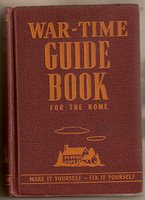History and Old Stuff...
 Old books are drawn to me as surely as Wooly Willy's beard is drawn to the magnetic pencil. ) I was just casually glancing at a bookcase at a tag sale today when The War-Time Guide Book caught my eye and demanded that I purchase it. It was only $2.50, so I did not resist.
Old books are drawn to me as surely as Wooly Willy's beard is drawn to the magnetic pencil. ) I was just casually glancing at a bookcase at a tag sale today when The War-Time Guide Book caught my eye and demanded that I purchase it. It was only $2.50, so I did not resist.This book was published in 1942 by the Popular Science Publishing Company, Inc. and it has two parts that are complete books themselves with their own indexes. Part I is titled, "Make It Yourself," and it includes, "Formulas, recipes, methods and secret processes for the handy man in meeting a multitude of household needs." Part II is titled, "Fix It Yourself," and its topics are, "Home maintenance and repairs in carpentry, plumbing, electrical equipment, concrete, metal work and automobiles." On the facing page, readers are advised that the book's publishers take do not guarantee and take no responsibility for the results of any recipe in the book. Hmmm.
The topics are arranged alphabetically so the first pages of the book plunge right into the War with sections on "Air Raid Protection" and "Blackouts". Thereafter the topics become more mundane, consisting mostly of many, many recipes for everything imaginable. A 22-page section is devoted to recipes for cosmetics of all sorts, from vanishing cream to grease paint for the theater. Except for the cosmetics recipes, most of the pages are devoted to formulas for things like wood finishes, poisons for flies and rats, photograph-developing solutions, glues, and so on.
It is interesting to see in the paints section that in 1942, recommended paint bases were "white lead" or "red lead". I was surprised to read that, "A form of wall decoration now much in vogue is sponge stippling," and a little later, a description of stippling using a crumpled newspaper or cloth. In 2006, those techniques are in vogue all over again.
Some of the information in this old book is so dated that it's hardly useful beyond being interesting to browse through, but some of it is still as helpful as when it was printed. For example, the step-by-step instructions of how to build a bookcase will still make the same sturdy piece of furniture today.
I had an obligation to buy this old book, you know. If I hadn't, it might have fallen into the hands of someone who didn't appreciate it for the jewel it is. I will never throw it away. It may gather some dust from time to time, but every now and then, I will get it out and enjoy it. I may eventually give it to someone who admires and deserves it. What more could an old book want?
No comments:
Post a Comment